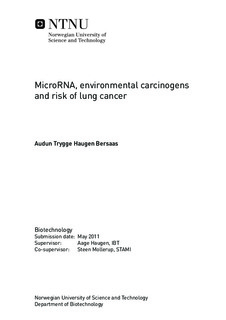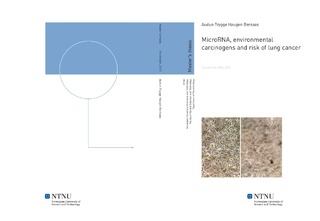| dc.description.abstract | Lung cancer is the leading cause of cancer related deaths world wide. The major cause of lung cancer is tobacco smoking. Tobacco smoke contains many different carcinogens including polycyclic aromatic hydrocarbons (PAH), which are known to cause DNA damage and initiate tumourigenesis.The aryl hydrocarbon receptor (AHR) is a basic helix-loop-helix protein of the PER-ARNT-SIM (PAS) family of transcription factors, which is involved in many biological processes including development, cell cycle regulation, cell differentiation, cell-cell signalling, cellular growth, and circadian rhythms. Most of the known function of AHR, however, is regarding its role in transcriptional induction of xenobiotic metabolis- ing enzymes (XMEs). In the lung, PAHs bind and activate the AHR, leading to transcriptional induction of members of the cytochrome P450 (CYP) enzyme family that are involved in activation of pro-carcinogenic PAHs to carcinogenic metabolites.MicroRNAs (miRNAs), a group of short non-coding RNA molecules, mediate sequence specific silencing of messenger RNAs (mRNAs) and are important in regulation of gene expression. The deregula- tion of certain miRNAs has been observed in several types of cancer, including lung cancer. Like mRNAs, miRNAs belong to the class II type of genes, and transcription of these types of RNA can therefore be regulated by the same transcription factors.Little is known regarding the role of miRNAs in environmental toxicology. The aim of this thesis was to identify miRNAs regulated by the AHR, and consequently may be important in mediating toxicity of tobacco smoke carcinogens.Expression levels of 750 miRNAs in mouse lung of Ahr wild-type and knockout animals were pro- filed by RT-qPCR arrays. Fifteen miRNAs were found to be differentially expressed between the groups, of which only one was up-regulated. The biological pathways in which these miRNAs may be involved were studied by an bioinformatic approach. Four miRNAs from the mouse experiment, whose expression were most significantly divergent, together with three miRNAs previously reported to be regulated by the Ahr in murine cell lines, were studied in an RNA interference (RNAi) experiment in immortalised human lung epithelial cell lines. Two of these miRNAs, both selected from the literature, were found to have altered expression in AHR knockdown cells compared to control cells. Discrepancies between AHR regulated miRNAs identified in the in vivo and in vitro experiments were observed. Taken together this suggest a difference between effect of the AHR in vivo and in vitro, rather than differences between species.In conclusion, it was found that expression of several miRNAs possibly is regulated in an AHR- dependent manner in lung. Discrepancies between in vivo and in vitro experiments suggest that care must be taken when extrapolating miRNA expression data from cell culture studies to whole organs or organisms. | nb_NO |

